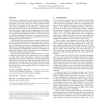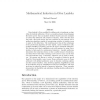17 search results - page 3 / 4 » On the Deduction Rule and the Number of Proof Lines |
FOCS
2007
IEEE
13 years 11 months ago
2007
IEEE
: We study the computational strength of quantum particles (each of finite dimensionality) arranged on a line. First, we prove that it is possible to perform universal adiabatic q...
ICFP
2009
ACM
14 years 5 months ago
2009
ACM
We present a new approach for constructing and verifying higherorder, imperative programs using the Coq proof assistant. We build on the past work on the Ynot system, which is bas...
JAR
2006
13 years 4 months ago
2006
Otter-lambda is Otter modified by adding code to implement an algorithm for lambda unification. Otter is a resolution-based, clause-language first-order prover that accumulates de...
FSS
2006
13 years 4 months ago
2006
An implication operator A is said to be tied if there is a binary operation T that ties A; that is, the identity A(a, A(b, z)) = A(T (a, b), z) holds for all a, b, z. We aim at th...
CADE
2007
Springer
14 years 5 months ago
2007
Springer
MaLARea (a Machine Learner for Automated Reasoning) is a simple metasystem iteratively combining deductive Automated Reasoning tools (now the E and the SPASS ATP systems) with a m...


